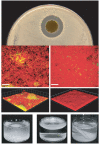Bacterial competition: surviving and thriving in the microbial jungle
- PMID: 19946288
- PMCID: PMC2879262
- DOI: 10.1038/nrmicro2259
Bacterial competition: surviving and thriving in the microbial jungle
Abstract
Most natural environments harbour a stunningly diverse collection of microbial species. In these communities, bacteria compete with their neighbours for space and resources. Laboratory experiments with pure and mixed cultures have revealed many active mechanisms by which bacteria can impair or kill other microorganisms. In addition, a growing body of theoretical and experimental population studies indicates that the interactions within and between bacterial species can have a profound impact on the outcome of competition in nature. The next challenge is to integrate the findings of these laboratory and theoretical studies and to evaluate the predictions that they generate in more natural settings.
Figures




References
-
- Schluter D. Ecological causes of adaptive radiation. Am. Nat. 1996;148:S40.
-
- Connell JH. The influence of interspecific competition and other factors on the distribution of the barnacle Chthamalus stellatus. Ecology. 1961;42:710–723.
-
- Monod J. The growth of bacterial cultures. Annu. Rev. Microbiol. 1949;3:371–394.
Publication types
MeSH terms
Grants and funding
LinkOut - more resources
Full Text Sources
Other Literature Sources

